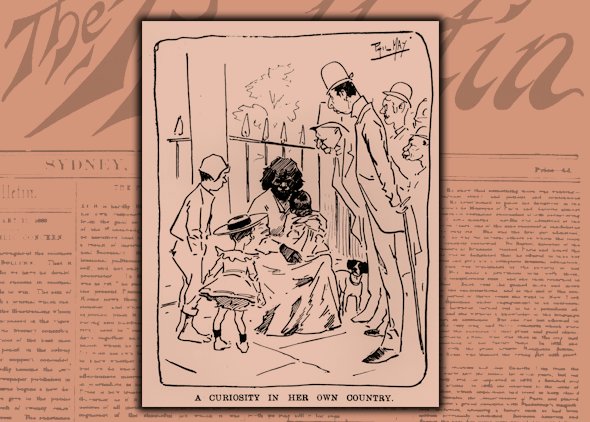Description
This black-and-white cartoon shows an Indigenous mother and her child who are dressed in European-style clothes and seated in what appears to be a city street. They are surrounded by rudely staring non-Indigenous onlookers, including a Chinese man. The cartoon by Phil May is captioned 'A CURIOSITY IN HER OWN COUNTRY.' It appeared in the Bulletin on 3 March 1888. This reproduction of the cartoon has been superimposed on the front cover of the Bulletin. The original image appeared in the text of the magazine.
Educational value
- This image represents the situation for Indigenous people in urban Australia in 1888, the centenary year of British colonisation. Dispossessed of their land, many living in poverty, most of the Indigenous people of what became New South Wales were concentrated on reserves or living in camps on the fringes of towns and cities. They were out of sight of most non-Indigenous Australians, particularly city dwellers, many of whom had rarely seen an Indigenous person.
- In 1888 a 'curiosity', used ironically in the caption, meant something that was unusual or an item worthy of a place in a collection. It was about this time that the traditional cultures of Indigenous Australians were beginning to be the subjects of anthropological study, and extensive ethnographical collections were being compiled.
- The cartoonist uses satire to highlight the difficult situation for many Indigenous Australians by juxtaposing the idea of the Indigenous mother and child being seen as a 'curiosity' with the fact that the woman is 'in her own country'.
- The Indigenous woman and her child are drawn realistically, while the peering onlookers are presented as caricatures. The inclusion of a Chinese participant in this drawing has been interpreted as May pointing out a racial double standard. In 1888 the Bulletin was running an anti-Chinese campaign, but in the image the Chinese man and other onlookers are shown as one united group.
- Most non-Indigenous Australians in 1888 would not have agreed that Australia was the woman's 'own country'. Many believed it had never been. In common with the British legal doctrine on which land tenure was based, such people believed that Australia was 'terra nullius' - nobody's land - before British colonisation. They acknowledged no pre-existing land-ownership rights for Indigenous peoples at all.
- May's drawing of a mother and healthy child would have cast some doubt on the belief among many non-Indigenous Australians that Indigenous people were a dying race. While this was not true, Australia's Indigenous population had been decimated due to diseases, conflicts and loss of country caused by British colonisation.
